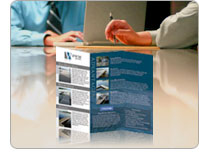- Products
-
Design Templates
- Featured Design Galleries
- More Galleries
- Services & Resources
- Free Sample Kit
- Deals
Brochures serve as one of the staple marketing materials of any business — they can give a corporate overview or actively promote a particular product, service or special offer. That's why good graphic designers take great care when planning and designing brochures. If you want your business or your clients' businesses to stand out through compelling brochures, make sure to avoid the following top five brochure blunders.
 1. Trying to print brochures yourself
1. Trying to print brochures yourselfPrinting brochures yourself can definitely be tempting. You might think that it will save money to print a brochure from your personal or company printer; however, problems can arise, including inaccurate colors, crooked folds when doing it by hand, faded ink and an amateur look. Getting your brochures professionally printed ensures that clients will not receive something that says your company makes mistakes or takes shortcuts.
It is important to use the correct printing templates when designing your brochure or the printed piece could be misaligned. Templates vary depending on the folding method needed, and these files provide information on product dimensions, layout, bleed, safety zone and any folding or mailing guidelines. Templates make it easier for you to create accurate, print-ready files in any of the major graphic design programs. To make it even easier for you, PsPrint offers free brochure layout templates.
 Good design draws attention to the most important text of any printed brochures. Sometimes designers forget this, however, and try to cram too much information into too small a space, or simplify everything into bulleted points. Don't go beyond four or five bulleted points or the impact of each will be lost on the reader. Even worse, some designers overload brochures with graphics and images, while aesthetically invigorating, doing this will distract from the brochure's message and result in a lower return on investment. Try to balance graphics and text, leave plenty of white space and make sure you use graphical elements to draw attention to the most important text (the offer, special sales, etc.).
Good design draws attention to the most important text of any printed brochures. Sometimes designers forget this, however, and try to cram too much information into too small a space, or simplify everything into bulleted points. Don't go beyond four or five bulleted points or the impact of each will be lost on the reader. Even worse, some designers overload brochures with graphics and images, while aesthetically invigorating, doing this will distract from the brochure's message and result in a lower return on investment. Try to balance graphics and text, leave plenty of white space and make sure you use graphical elements to draw attention to the most important text (the offer, special sales, etc.).
To be blunt, nobody cares about your company or your clients' company. All your brochure readers are concerned with is how your company can help them. This is a fact well-known by the top marketers and copywriters, but is all-too-often ignored by amateur brochure writers. If your brochure simply drones on about the company, you'll lose reader interest and sales. Make your copy pop by espousing the features and benefits of doing business with your company and their products and services. The bottom line: Tell your readers what you can do to solve their problems, make life easier, make their business more profitable, etc., and you'll hook your readers and drive your response rate through the roof.
Like business cards, brochures can — and should — be distributed anywhere and everywhere. Unfortunately, some companies only give brochures to prospects that have already walked through their door. Once prospects have contacted them, however, the brochure is essentially worthless in comparison to what a face-to-face pitch can do. Rather, brochures should drive prospects to your business to set up a face-to-face meeting; and therefore should be widely circulated. Many Chambers of Commerce and other organizations offer brochure slots for members. Some of the major newspapers offer deals where you can insert brochures into variety advertisement packs, and you can leave brochures laying anywhere potential prospects might pick them up (without littering, of course). Even better, brochures are perfect for bulk-mailing campaigns, because they can contain a large amount of information, persuade prospects to follow a powerful call to action, and full-color brochure printing is economical. If you don't have a mailing list, PsPrint offers a list-building service to help you get started. Before you send your next brochure to the press, take a quick look to make sure you haven't committed one of these brochure blunders. If you're in the clear, you're likely have an invigorating and compelling promotional piece sure to drive the return of investment - as long as it's distributed correctly.
Success! You're all signed up.